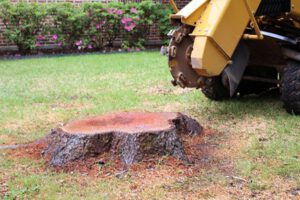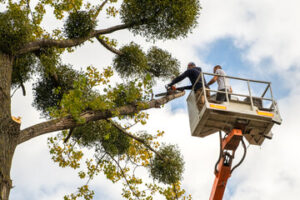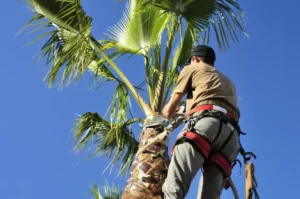Stump Removal Austin are eyesores that can attract pests, hinder mowing, and encourage unwanted weeds. They also take up valuable garden space.
The best and fastest way to remove a stump is by grinding it. It’s quick, thorough, and leaves the site ready for remodeling. This method requires heavy equipment, so think carefully about how to get the machine in place and out again.

Stump removal using manual methods is often the most thorough option, but it can take the longest time. It involves cutting away the stump with a chainsaw or axe and then digging up the roots manually. This method can be especially difficult if the stump’s roots have grown into the turf, under driveways, around pipes, or into foundations. It’s often best to hire a professional to handle this type of work, as they have the appropriate tools and training to tackle it without damaging your yard or home.
Another way to remove a tree stump is by drilling holes into the major structure and injecting a chemical mixture that promotes rapid rot. The chemicals used for this purpose include potassium nitrate, sulphuric acid, and nitric acid. After a few weeks, the stump will be completely rotted and ready for removal. This is a good option for homeowners who are quick to finish the job and want to be sure it’s completed correctly.
You can use Epsom salt or rock salt to rot a stump or try a non-chemical alternative. First, drill holes into the stump’s surface and then fill each with salt. Cover the hole with a tarp or other protective material to prevent moisture and contamination from getting in. It takes about three or four weeks for the stump to become soft and rotten enough to remove with an ax or hatchet.
When you’re ready to take the next step, removing the remaining part of the stump can be as simple as burning it. If you go this route, it’s important to use caution and follow local laws regarding the safe disposal of waste. You should also encase the stump in chicken wire and remove all leaves from nearby areas to prevent fire hazards. This is a great option for people who want to avoid the long, drawn-out process of stump grinding. This is often the fastest and most effective method of removing a stump. However, it’s still worth contacting a tree service to see your options for the most thorough and cost-effective method of stump removal.
A large stump can create a tripping hazard for anyone walking through your yard. It may also attract insects and critters that can damage the lawn or garden. Using a stump removal chemical is an effective way to kill the stump and protect your property.
There are many different types of stump remover chemicals, but most contain potassium nitrate. This chemical is one of the best for killing green stumps and encouraging decomposition in decaying seasoned stumps. Most products that contain potassium nitrate are in the form of granules, making them easy to apply.
Other popular stump removal chemicals include copper sulfate and triclopyr. While triclopyr is a powerful herbicide that can kill any plant it touches, including grass and trees, it can be dangerous to children, pets, livestock, and wildlife. On the other hand, copper sulfate is a safer alternative to triclopyr and is an excellent deterrent for mosquitoes, insect larvae, and other pests.
Most stump-killing chemicals require drilling holes in the surface of the tree stump and applying the chemical. Once used, the chemical can sit for a while to ensure it has time to work its magic. The time it takes for a stump to rot and break down depends on the size and type of tree and the climate. Soaking the area and covering it with a plastic tarp can help speed up the process.
Several liquid tree stump killers are on the market for those who prefer not to use a powder. One of the most popular is Stump-Out, which has high reviews on online product review sites. Another option is Spectracide, which uses picloram to kill the stump and roots.
It is important to remember that although stump removal chemicals can be a fast and effective solution, they are not environmentally friendly. They leave a toxic residue that can contaminate surrounding plants and wildlife. If you’re looking for a more ecological option, consider using a stump grinder to grind up the stump and then fill in the hole with soil and sod.
A stump and its root system can be unsightly and take up valuable yard space. They can also be a safety hazard for children and pets playing in the area, become home to unwelcome pests such as termites and carpenter ants, and attract fungus. Left untouched, they can also grow into other trees, plants, and structures in the landscape and cause damage to the soil, water, or sewer lines.
If you are willing to put in the time and effort, you can manually remove a stump from your yard using the chop-and-pull method. This involves digging around the stump and roots with a shovel and cutting them with an ax, hatchet, or chainsaw to expose as many main roots as possible. Once you have served as many roots as possible, you can use a power drill to make holes in the stump that are an inch wide and eight to 12 inches deep, three to four inches apart. Then, you can pour the chemical potassium nitrate into each hole. This will accelerate the decomposition of the stump and make it easier to remove.
Alternatively, you can cover the stump with a tarp and mulch, then wait for it to rot. After a few weeks, it will be soft and spongy enough to break apart with an axe or a chainsaw. You can repeat the process to speed up the rotting process and prepare the site for new planting.
You can even use the resulting wood chips as mulch for the rest of your landscaping. And if you’re feeling creative, you can turn the stump into an artistic feature in your yard by building a fairy or gnome house, seating, or planter. However, if you’re looking for a more efficient solution, consider calling a professional to grind or remove your tree stumps. They can use a mechanical stump grinder or chemical treatment to speed up the decay process and make the stump easier to remove, ensuring that it won’t be a tripping hazard for you, your family, or your guests.
One of the most effective ways to remove a tree stump is using modern equipment, such as a stump grinder. However, This can be challenging to operate and may be expensive. Nevertheless, it is the most effective way to eliminate a stubborn stump.
Another way to kill a stump is with boiling water. To use this method, first expose as much of the stump’s root system as possible. Next, drill holes into the roots and on top of the stump. Finally, pour boiling water over the entire stump and its roots. This will shock the roots and cause intense damage, resulting in death.
You can pour kerosene or fuel oil into the holes you drilled for a quicker, more labor-free alternative. Allow the liquid to absorb into the stump for a few weeks before lighting it on fire. This will quickly burn out the stump and leave a charcoal-filled hole behind.
You can also use Epsom salt or rock salt to kill a stump. To do this, drill holes into the stump’s surface and fill each hole with the salts. Then, cover the entire stump with a light-proof tarp. The tarp will shield the stump from sunlight and help accelerate the natural decomposition process. After a few months, the stump should be dead and can then be pulled out of the ground.
Lastly, you can use a chemical such as phosphorous to kill the stump. This is especially useful if you’re trying to eliminate an old and unhealthy stump that will not die naturally. Pour the chemical onto the stump and let it soak in for a few days. Then, light a fire on top of and around the stump. The fire will burn out the stump and bury any remaining parts of the wood in ash.
Stump removal is an important lawn and garden project. It can help you save space by removing the unsightly remains of a fallen tree and making way for new plants, such as grass, flowers, or shrubs. It can also prevent the spread of unwanted or invasive plant species. Finally, it can improve your yard’s overall look and enhance your home’s beauty. However, before chopping and grinding, check local laws regarding open-flame burning.


